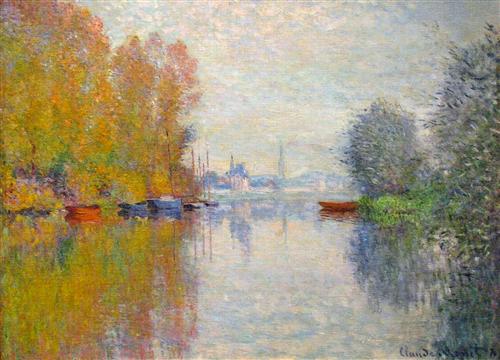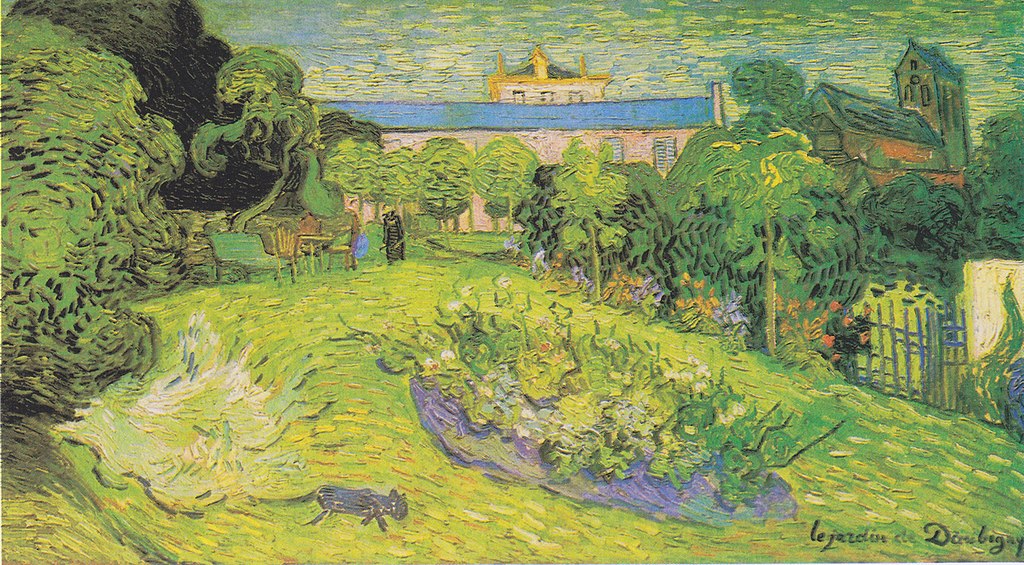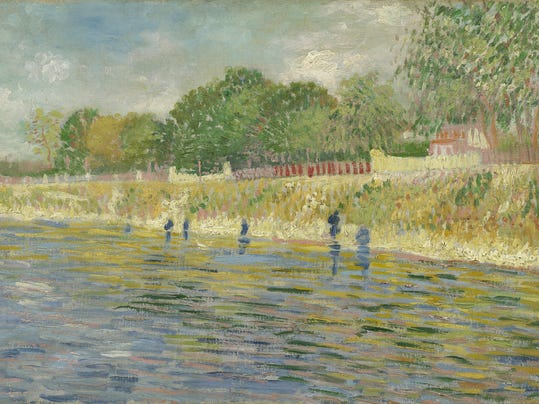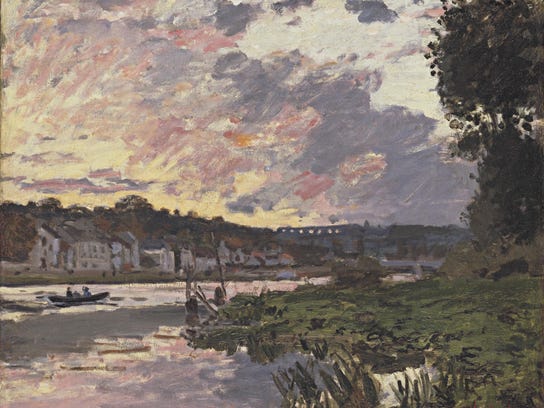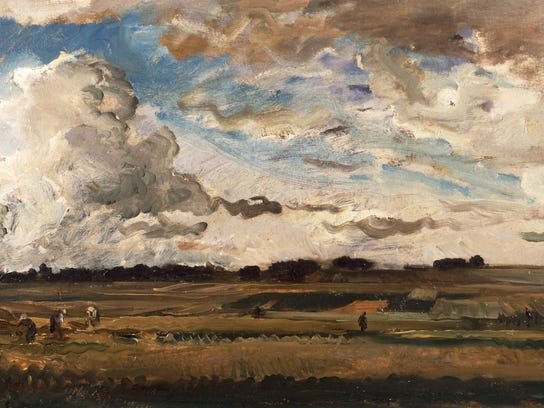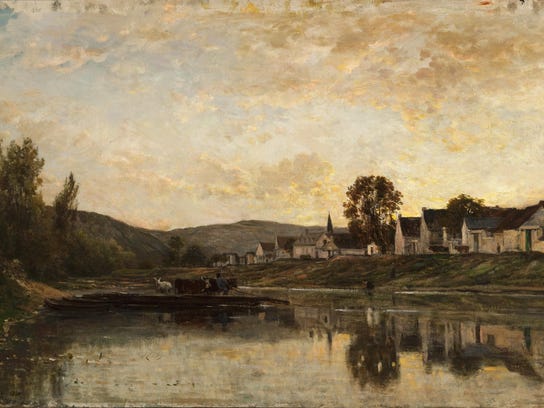Pushing the
boundaries of traditional landscape painting, Charles François Daubigny (1817–78)
was a vital touchstone and mentor for the subsequent generation of avant-garde
artists now widely celebrated as the Impressionists. In the 1850s and 1860s,
Daubigny routinely painted outdoors to directly capture qualities of light and
atmosphere, launched a floating studio boat on French waterways that
fundamentally changed the way artists could frame their compositions, employed
radical painterly techniques and exhibited sketch-like works that critics
assailed as “mere impressions.”
Though an inspiration
to artists such as Claude Monet, Camille Pissarro and Vincent Van Gogh, Daubigny
is now relatively unknown. Until this year he has never been the subject of a
major international exhibition, and no exhibition has previously examined Daubigny’s
profound influence upon the Impressionists and in turn their influence on his
late style.
Co-organized by the
Taft Museum of Art, the Scottish National Gallery and the Van Gogh Museum, Daubigny, Monet, Van Gogh: Impressions of
Landscape revises our understanding of the origins of Impressionism by
reconsidering Daubigny as a central figure in the development of 19th-century
French landscape painting, including Impressionism.
The groundbreaking exhibition
will be on view at the Taft Museum of Art in Cincinnati, Ohio, the sole U.S.
venue, from Feb. 20 through May 29, 2016. It will travel to the Scottish
National Gallery in Edinburgh and the Van Gogh Museum in Amsterdaml ater in
2016 and in early 2017.
In addition to one of
the Taft’s Daubigny paintings, which prompted the exhibition, Daubigny, Monet, Van Gogh: Impressions of
Landscape will also feature spectacular loans from numerous North American
and European museums—including the Art Institute of Chicago; Montreal Museum of
Fine Arts; National Gallery, London; Museum of Fine Arts, Bordeaux; Scottish
National Gallery, Edinburgh; Van Gogh Museum, Amsterdam—and private collections.
“Conceived at the
Taft, this very special exhibition reflects the museum’s strength in European
art and its strong relationshipswith a host of distinguished international
institutions,” said Taft Director and CEO Deborah Emont Scott.“ We are thrilled
to bring this stellar group of European works of art to our greater Cincinnati,
regional and national audiences.”
Of the 55 paintings
in the exhibition, approximately 40 masterpieces by Daubigny will showcase the
full range of the artist’s achievements over four decades, including both small
easel paintings created outdoors and grand-scale paintings completed in the
studio for exhibition.
The remainder of the
works on view will offer ascinating and often surprising comparisons with Impressionist
and Post-Impressionist paintings by Claude Monet, Camille Pissarro and Vincent Van
Gogh, revealing Daubigny’s impact on and importance for two subsequent
generations of artists, the Impressionists and the Post-Impressionist Van Gogh.
“This exhibition stakes
a claim for Daubigny’s inadequately recognized achievements as a powerful
innovator and precursor to one of the most original art historical movements of
all time,” said Lynne Ambrosini, Director of Collections and Exhibitions and
Curator of European Artat the Taft Museum of Art. Ambrosini is the initiating curator
(and one of five curators) of the exhibition.
In the vanguard of
artists who privileged and embraced the immediacy of open-air painting, Daubigny
invented the studio boat and was the first to paint views surrounded by water
instead of from the riverbanks. This pioneering compositional technique of
stripping away conventional foregrounds to more directly observe nature and
capture the effects of light, as well as his radically unfinished painting
style and brighter palette, had a powerful influence on the young Impressionists.
Highlights of the
exhibition include Daubigny’s images of silvery light and reflections along the
Seine and Oise rivers, stormy atmospheric effects at the Normandy coast, dramatic
moonlit landscapes, views of lush fields and scenes of blossoming orchards in
the countryside outside Paris—the last another subject he invented. These
subjects were soon taken up by Monet and Pissarro, whose similarly themed works
will also be featured, for example
Pissarro’s The Banks of
the Oise near Pontoise (1873, Indianapolis Museum of Art),
Monet’s Autumn on the
Seine, Argenteuil, (1873, High Museum of Art, Atlanta, Georgia), which was
painted from Monet’s emulative studio boat.
Daubigny’s panoramic
views of the sunny grain-fields near Auvers were admired by Van Gogh, who
adopted Daubigny’s then famous double-wide canvas formats for his own pictures
of the plains near Auvers.
The final section of
the exhibition presents five masterpieces by Van Gogh that reveal his debt to
Daubigny, including
Daubigny’s Garden 1890,
R. Staechelin Collection, Basel, Switzerland),
which exhibits Van
Gogh’s signature swirling intensity.
(Daubigny's Garden, painted three times by Vincent van Gogh, depicts the enclosed garden of Charles-François Daubigny, a painter whom Van Gogh admired throughout his life. Van Gogh started with a small study of a section of the garden. Then he worked on two double-square paintings of the full walled garden. The paintings were made in Auvers between May and July 1890, during the last few months of his life. All three paintings are titled Daubigny's Garden and are distinguished by the museums they reside in: Kunstmuseum Basel, Hiroshima Museum of Art and Van Gogh Museum.)
(Daubigny's Garden, painted three times by Vincent van Gogh, depicts the enclosed garden of Charles-François Daubigny, a painter whom Van Gogh admired throughout his life. Van Gogh started with a small study of a section of the garden. Then he worked on two double-square paintings of the full walled garden. The paintings were made in Auvers between May and July 1890, during the last few months of his life. All three paintings are titled Daubigny's Garden and are distinguished by the museums they reside in: Kunstmuseum Basel, Hiroshima Museum of Art and Van Gogh Museum.)
About the Artist
From relatively
humble beginnings in Paris, Daubigny rose over the course of a long and eventually
acclaimed and successful career to help redefine French landscape painting. As
a teenager he worked at the Louvre restoring paintings and subsequently began
studies with artists Pierre-Asthasie-Théodore Sentièsand Paul Delaroche.
Daubigny’s travel to
Italy and extensive working trips in France inspired his rural and river views
of his country, which were exhibited and recognized at the annual Salons along
with compositions by his peers, including Camille Corot, Gustave Courbet,
Théodore Rousseau and Jean-François Millet.
A fully illustrated176-page catalogue presenting significant new research about early Impressionism,
Daubigny and Van Gogh by leading scholars in the field will accompany the exhibition.
Essayists include the Taft’s Lynne Ambrosini, with two essays on Daubigny’s
legacy andonthe market for his landscapes; Michael Clarke, Director of the
Scottish National Gallery, who explores Daubigny’s river scenes; Maite van
Dijk, Curator of Paintings, Van Gogh Museum (VGM), on Daubigny and
Impressionists in the 1860s; Frances Fowle, Senior Curator of French Art,
Scottish National Gallery, who considers Auvers-sur-Oise as a site of artistic
production; Nienke Bakker, Curator of Paintings, VGM, who examines Van Gogh’s
admiration of and responses to Daubigny; and René Boitelle, Senior Paintings
Conservator, VGM, on Daubigny’s late painting techniques. The catalogue will be
published by the National Galleries of Scotland and distributed by ACC
Distribution, USA and UK.
More images from the exhibition:
Charles François Daubigny - The Coming Storm, Early Spring circa 1865-1875 Walters Art Museum - Baltimore
Vincent van Gogh, The Banks of the Seine, 1887, oil on canvas. Van Gogh Museum, Amsterdam, The Netherlands
Claude Monet, Scene at Bougival, Evening, 1869, oil on canvas, Smith College Museum of Art, Northampton, Massachusetts
Charles François Daubigny, Landscape with Harvesters, 1875, oil on canvas. Museum Gouda, The Netherlands
Charles François Daubigny, Ferryboat near Bonnières-sur-Seine, 1861, oil on canvas. Bequest of Charles Phelps and Anna Sinton Taft, Taft Museum of Art, Cincinnati, Ohio
More images from the exhibition:
Charles
François Daubigny, The Beach at Villerville at Sunset, 1873, oil on canvas. Chrysler
Museum, Norfolk, Gift of Walter P. Chrysler, Jr.
Charles
François Daubigny, Moonrise at Auvers or Return of the Flock, 1877, oil on canvas.
The Montreal Museum of Fine Arts, Gift of Lady Drummondin memory of her husband,
Sir George A. Drummond
Charles
François Daubigny, Orchard in Blossom, 1874, oil on canvas. Scottish National Gallery,
Edinburgh
Charles
François Daubigny, Sunset near Villerville, about 1876, oil on canvas. The Mesdag
Collection, The Hague
Charles
François Daubigny, The Village of Gloton, 1857, oil on panel. San Francisco Fine
Arts Museums, Mildred Anna Williams Collection
Claude
Monet, Autumn on the Seine, Argenteuil, 1873, oil on canvas. High Museum of Art,
Atlanta; Purchase with funds from the Forward Arts Foundation, The Buisson Foundation,
Eleanor McDonald Storza Estate, Frances Cheney Boggs Estate, Katherine John
Murphy Foundation, and High Museum of Art Enhancement Fund, 2000.205
Claude
Monet, Houses on the Achterzaan, 1871, oil on canvas. Lent by The Metropolitan
Museum of Art, New York, Robert Lehman Collection, 1975 (1975.1.196)
Claude
Monet, The Studio Boat, 1876, oil on canvas. Musée d’art et d’histoire, Neuchâtel Vincent van Gogh, Daubigny’s Garden, 1890, oil on canvas. The Rudolf Staechelin Collection
Vincent
van Gogh, Orchard in Blossom, 1889, oil on canvas. Van Gogh Museum, Amsterdam
(Vincent van Gogh Foundation)
Vincent
van Gogh, Wheat Fields after the Rain (The Plain of Auvers), 1890, oil on
canvas. Carnegie Museum of Art, Pittsburgh; Acquired through the generosity of
the Sarah Mellon Scaife Family, 68.18
Charles
François Daubigny, The Dunes at Camiers, 1871, oil on canvas. Lent by The Minneapolis
Institute of Arts, Gift of Wheelock Whitney, Wheelock Whitney III, Pennell Whitney
Ballentine, Joseph Hixon Whitney, and Benson Kelley Whitney in memory of Irene
Hixon Whitney
Charles François Daubigny - The Coming Storm, Early Spring circa 1865-1875 Walters Art Museum - Baltimore
Vincent van Gogh, The Banks of the Seine, 1887, oil on canvas. Van Gogh Museum, Amsterdam, The Netherlands
Claude Monet, Scene at Bougival, Evening, 1869, oil on canvas, Smith College Museum of Art, Northampton, Massachusetts
Charles François Daubigny, Landscape with Harvesters, 1875, oil on canvas. Museum Gouda, The Netherlands
Charles François Daubigny, Ferryboat near Bonnières-sur-Seine, 1861, oil on canvas. Bequest of Charles Phelps and Anna Sinton Taft, Taft Museum of Art, Cincinnati, Ohio

